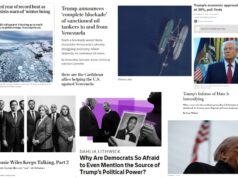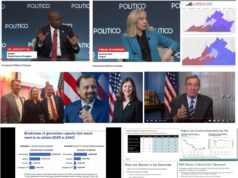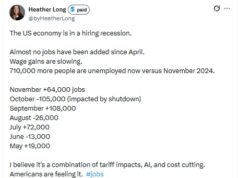From Gov. Northam’s office; good to see a lot of this, including the proposed 2% pay raise for teachers (“if we see our revenues improve as we expect next month, I’ll push to change this one-time bonus into a permanent pay raise of at least 2 percent”).
|
|
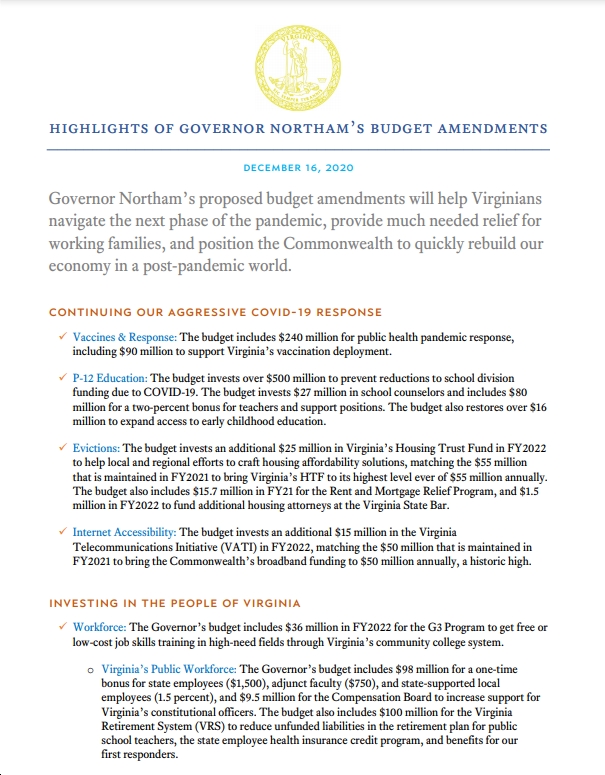
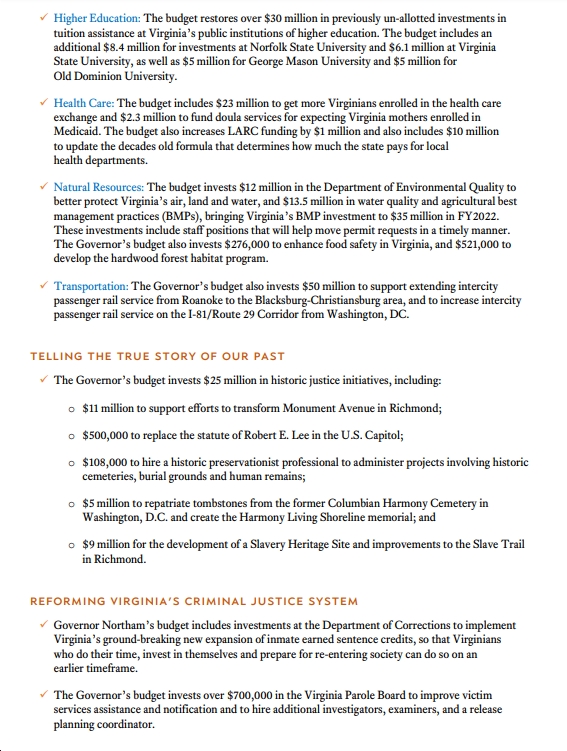
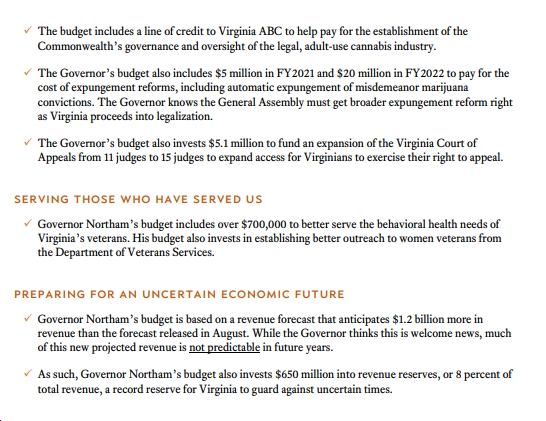
AS PREPARED FOR DELIVERY:
Good morning, Chairwoman Howell, Chairman Torian, Chairwoman Watts, Speaker Filler-Corn, and members of the General Assembly, ladies and gentlemen. Thank you for the privilege of speaking with you this morning.
I would like to recognize Lieutenant Governor Justin Fairfax, Attorney General Mark Herring, my wife Pam, and members of our Cabinet and staff.
We’d rather all be meeting in person today. But it is much safer to meet this way, as the covid-19 pandemic starts its tenth month and cases rise.
And before we turn to today’s business and discuss our budget proposals, I’d like to give a short update on the pandemic. Throughout the long months of this health crisis, Virginia has done comparatively well. Our efforts to bend the curve early on worked, and the virus spread through the Commonwealth slowly for most of the past ten months.
Unfortunately, the spread is increasing around the country and here in Virginia too. Our percent positivity has doubled in the past month, as have our daily new case counts. More people are being hospitalized, and unfortunately, more are dying. Virginia is still doing better than about 45 other states, on a per capita basis. But this virus is spreading fast, and we all need to continue to be as careful as possible. Wear a mask, avoid social gatherings, stay six feet away from others, wash your hands.
Vaccines are now being deployed in Virginia. Health care workers got the first shots yesterday. And while it will take months to vaccinate everyone, we can now start to look to the future with hope. We’re all tired, but this is not the time to let down your guard or be reckless.
We have crafted this budget against the backdrop of the pandemic. The plan I will present to you today is intended to help Virginians navigate the next phase of the crisis, and perhaps, its final months. It will position us to recover as quickly as possible as we rebuild our economy in a post-pandemic world. And it’s about advancing the progressive agenda that we all embarked upon together a year ago.
Now, if it feels like we just did this budget exercise, well—we did. In August, I called the General Assembly into special session to deal with the pandemic’s effects on our revenues and budget. The budget I proposed then focused on preserving liquidity to deliver services and pay our bills. It ensured that we did not destabilize our financial footing by using one-time money to pay for recurring expenses.
It preserved financial options, because we cannot predict the future, especially in a pandemic. It made targeted investments to help guide Virginia through the crisis. And it restored funding for priorities that will make Virginia stronger, such as investments in historically black colleges and universities and African American historical and cultural sites; stable and affordable housing; broadband access; and reforms to modernize our criminal justice system. I thank you for your diligent work, returning to me a budget that aligned with our shared priorities. I was pleased to sign that budget just over a month ago.
The budget I present today preserves our focus on flexibility, targeted investments, and help for Virginians. While we believe an end to this crisis—and a rebounding of our economy—is in sight, we are not there yet.
We must continue to make choices that help Virginians get through these times. You will see investments in vaccination, affordable housing, skills training, and early childhood education, for example.
We have put a special focus on the second year of the budget, which starts next July. By then, we hope most Virginians will be vaccinated, and our society—and economy—will have begun returning to more normal activities.
Helping support this recovery takes investment and planning as well, and you will see that in this budget. When we crafted the last budget in August, our team of outside economic advisors had met, and agreed on a new economic forecast for Virginia. It was recessionary—while Virginia’s revenues did not take as great a hit from the pandemic as we expected early in the year, we did see a slowing economy and revenue losses, and that was expected to continue.
That team of advisors met again last month, to revise the forecast again in light of current conditions. Our economic picture is now more stable, and we can expect more revenue over the coming year and a half than was predicted in August. This is good news.
Based on the expert advice of economists and business leaders, our team now estimates $1.2 billion in additional revenue in this biennium. We all need to understand how important this is: Revenues are exceeding official forecasts, even during a pandemic. This is in sharp contrast to other states.
Other states have laid off workers, cut services, and even borrowed money to pay the bills—actions that will weaken their financial pictures for years to come. But in Virginia, our finances are solid, and the actions we have taken have kept our triple-A bond rating secure. We are one of only 13 states that hold this rating, and it’s because we laid out a long-term financial plan, and we have stuck to it, in good times and bad. We must continue this work.
These additional revenues are what allow us to help Virginians who need it, and prepare for recovery. You’ll see throughout this budget that our spending decisions are focused on supporting people now, and building foundations for the future.
Part of that foundation is a healthy reserve fund. That is why I am allocating $650 million to our reserves. This level of reserve funding will get us to the goal of having 8 percent in reserves by the end of my term. This is more than any previous governor of either party.
It’s important to note that these are dollars we had previously earmarked for reserves, then unallotted. They come from one-time cash balances, which is why they should not be used to pay for ongoing programs. Instead, putting them in reserves makes sure they’re accessible if revenues don’t grow as quickly as expected, so we won’t have to make budget cuts.
While we expect to turn a corner on this pandemic in the coming months, if there is anything we have learned this year, it is to prepare for the unexpected. Putting these revenues in reserves gives us flexibility.
It’s important that we don’t promise one-time resources for ongoing spending. That’s why we’re using $100 million to reduce unfunded liabilities in the Virginia Retirement System. This one-time investment will focus on the retirement plan for public school teachers, the state employee health insurance credit program, and benefits for our first responders. This is sound fiscal policy that will keep VRS on a more solid footing—and importantly, it means our public servants can feel more secure about their future benefits.
For thousands of Virginians, the pandemic has meant lost jobs, lost income, and serious financial struggle. My administration has worked throughout this pandemic to help those folks who need it.
We have distributed $3.1 billion in federal CARES Act funding, helping individuals, businesses, health care providers, and local governments around the Commonwealth. That includes $1.3 billion to our localities, who have used it for innovative responses to the crisis.
We’ve seen small business support programs, hazard pay for health and public safety workers, technology investments, and a thousand other ways to help Virginians navigate this pandemic. I am hopeful that Congress will act soon to pass new legislation to provide additional assistance.
We took steps to make it as easy as we could to apply for unemployment, upgrading a system that was a generation old. We worked to put a moratorium on evictions and foreclosures for those having trouble paying their rent or mortgage.
We have dispersed more than $40 million in federal CARES Act funding to the Rent and Mortgage Relief Program to help more than 13,000 households, and we have earmarked $100 million to help people having trouble paying their utility bills during this crisis.
We know that just as individuals and families are struggling, so are our small businesses. We distributed nearly $100 million to help 2,500 small businesses across the Commonwealth survive.
While programs to help people with rent and utility payments continue, it’s also important to look ahead, and help unemployed Virginians get back on their feet. And to continue helping those who are struggling to keep a roof over their heads, this budget devotes $25 million to maintaining our historic investment in the Housing Trust Fund. This builds on the $85 million we put into that fund this biennium, an unprecedented investment in helping make sure people have stable housing.
As we invest in Virginians, we want to help those who are struggling get back on their feet. That’s why this budget partially restores funding for the G3 program, which we “unallotted” in April from the original budget.
G3—Get a Skill, Get a Job, Give Back—is a program I have championed since before I became Governor. It helps people get job skills training in high-need fields, through our community colleges. Even more importantly, it provides the financial aid necessary to help people get that training. G3 will provide free community college for certain low- and middle-income Virginians who enroll at our two-year colleges in pathways that lead to a high-demand job. These pathways include the skilled trades, healthcare, technology, early childhood, and public safety. For those folks who have seen their jobs disappear during this pandemic, G3 could be a lifeline. That’s why I have prioritized this important investment.
That is also why we’re allocating $30 million to restore financial aid increases at public colleges and universities across our Commonwealth. We had proposed these increases last winter, but unallotted them. We’re also restoring our plan to increase Tuition Assistance Grants for students at private institutions to $4,000.
For Virginia State University and Norfolk State University, our public historically black colleges and universities, which have long been underfunded, we’re proposing additional assistance to help support student access and success. While it is wonderful to open the newspaper this morning and see news of major philanthropic gifts to VSU and other HBCUs, this is in addition to, not in place of, state support that is still necessary.
And for George Mason University and Old Dominion University, we’re restoring funding to address enrollment disparities, increases in transfer students, and support educational program development.
I thank the General Assembly for working with us to ensure that some of our CARES act funding has gone to ensure people whose jobs have been impacted by the pandemic can get the training and credentials they need.
I have also maintained our historic level of funding for broadband in this budget—$50 million in each year. For G3 to work, for our students to access virtual classrooms, for businesses to survive, for Virginians to access telehealth—they need broadband internet. It is as critical now as electricity was in the last century. Increasing broadband access has been a priority since I took office, and the pandemic has simply highlighted how necessary it is.
Now I’d like to turn to our public schools. Of all the services administered by state and local governments, our schools have been the most disrupted by this pandemic. Early in the spring, schools quickly shifted to a virtual format. School divisions across Virginia have spent this fall working to balance learning with safety, trying to find the right combination of in-person, virtual, or hybrid learning.
Often the way children attend school has changed week by week, as local school boards and divisions respond to the evolving health situation in their local communities. I know this has been hard on every student, every teacher, every parent, and every school administrator in Virginia. I continue to be impressed with how school staff, students, and families have risen to meet these challenges.
As families have faced decisions about the best way to safely educate their child, school divisions have seen some drops in enrollment. We understand that every family must do what’s best for their children. We also expect enrollment numbers to rebound once the pandemic has subsided and in-person learning becomes the norm again. While these enrollment declines normally would result in less state funding that would devastate our public education system. That is why this budget helps school divisions, students, and teachers.
This budget accounts for the reduction in enrollment but also protects school divisions with funding to ensure they don’t suffer from any loss of funding under the enrollment formulas that drive the allocation of state dollars. We’re budgeting more than $500 million over two years to help schools weather this temporary decrease.
I also know that the challenging nature of this school year is hitting students especially hard. It is not easy for children to be separated from their friends, or to miss the school activities they enjoy. I believe our students need help now, more than ever. That is why I am providing $26.6 million in this budget to increase the number of school counselors. We have pushed for more school counselors for a long time, and this will ensure we have one full-time school counselor for every 325 students. Let’s get it done. The mental health of our students is too important to wait for another budget year.
So is the education of our littlest learners. This budget restores funding for early education, including a pilot program to provide three-year-olds access to early childhood education programs, and grants to address pay equity issues for early childhood educators. Early childhood education has been a priority for me since I was in medical school. The majority of brain development occurs in these early years. We want every child to enter kindergarten ready to learn.
Our teachers have gone above and beyond this year, adapting to new ways of connecting with their students, while protecting their own health and that of their families. My budget provides a 2 percent bonus for instructional and support positions. That is consistent with budget language from the General Assembly that says when our revenues get better, our teachers deserve to be rewarded—a goal we share.
We have worked for a long time to raise teacher pay. We were all proud in 2018 to give our teachers the largest single-year pay raise in 15 years. And last year, I proposed adding a three percent pay raise on top of that. While we had to unallot the money for that raise, teachers deserve it. So if we see our revenues improve as we expect next month, I’ll push to change this one-time bonus into a permanent pay raise of at least 2 percent. It is a small way to say thank you for your devotion to educating our children.
The budget also includes a bonus for state employees, adjunct faculty, and state-supported local employees. That includes local mental health workers and social workers, some state-supported law enforcement officers, and others. Workers in every government agency have had to adapt to changes this year. For some, it meant working from home.
For others, like our DMV workers, it has meant plexiglass barriers, masks in the office, and other new challenges. This is one simple way to say thank you.
I am grateful for every public servant in Virginia’s workforce. But our elections officials have had a particularly grueling year. They held multiple elections during a pandemic, and they did it successfully and smoothly. I am grateful to them. It is time to update our state voter registration system—a system that benefits everyone, no matter who you vote for. In a world where we have to worry about cyber attacks and bad actors, this is an investment in security so we stay ahead of them. I have included $16.7 million for this.
We all are heartened by the news of vaccines that are starting to be put into arms as we speak. This is the light at the end of a very long and dark tunnel. Vaccines are the only way we can end this pandemic and get back to a more normal life. But to do that, we must vaccinate millions of Virginians. That’s a lot of shots in a lot of arms. It will take a great deal of time, effort, and money. That money should come from the federal government. But we’ve all learned not to wait. So in this budget, I have provided $90 million to support this vaccination effort and ensure we have the supplies, staffing, and other infrastructure needed to vaccinate eight million Virginians.
The Virginia Department of Health has been planning for this mass vaccination effort for months, and they have hit the ground running as vaccine doses were shipped into the Commonwealth just this week.
We don’t always pay as much attention as we should to our public health departments, and the vital work they do. Under Virginia’s system, both the state and local governments have a role in operating our health departments. But the formula we use to determine how much the state pays for those local health departments hasn’t been updated in a generation—years in which Virginia has changed from a rural state to an urban and suburban one.
With this formula frozen in time, places that have seen their economies change—like Lee and Wise counties in the coalfields, or cities like Petersburg and Richmond—are stuck paying more than they should. Updating the formula is an equity issue, and we’re going to get it done this year. We’ll also make sure that no local health department gets less funding as a result.
And while the pandemic is the greatest public health crisis we have faced in modern times, we know that every day, Virginians face personal health issues—and sometimes, public policy can help them live healthier lives.
For example, maternal and neonatal mortality rates have changed little since 2004, and we also have seen an alarming racial disparity; Black mothers are more than twice as likely to die from complications from pregnancy as other mothers are.
Countless advocates have said: If you want to improve maternal health, expand the services you cover for pregnant women and new mothers. You should cover services by doulas. Doulas provide non-clinical support to pregnant women through their pregnancy and after they give birth, and multiple studies show they improve health outcomes for the mother and the baby. For that reason, this budget provides $2.4 million for doula services for pregnant women.
We are also providing $4 million over two years to expand access to long-acting reversible contraceptives. LARCS help women be in control of their own reproductive decisions, and that’s a good thing.
This budget also lays the groundwork to legalize marijuana in the Commonwealth. We know that laws to ban marijuana historically were based in discrimination, and criminalization laws have disproportionately harmed minority communities. Virginia has studied the experience of other states—including taxation, banking, criminal justice, licensing, and regulation. Our path forward will lead with social equity, public health, and public safety. This session is the time to get this done.
Reforming our marijuana laws is one way to ensure that Virginia is a more just state that works better for everyone. It also will eventually bring in tax revenue that can be used to further make sure we are providing equitable access to opportunity.
For example, just half of the potential annual revenue could pay for two years of quality Pre-K to every one of Virginia’s most vulnerable three- and four-year-olds—children who deserve the best start in life.
As we consider ways to make our criminal justice system more fair and equitable, we must talk about improving our system of expunging past crimes from people’s records.
I have put $20 million into this budget, so it will be ready when we conclude the important discussion of how best to conduct expungements. Like marijuana legalization, this is a priority that needs action in this session.
This is an important step toward modernizing our criminal justice system. We are also proposing to add four judges to Virginia’s Court of Appeals, along with support staff, to ensure the court can hear more appeals cases in a timely manner under an increasing workload.
2020 has been a landmark year. Not only has the pandemic upended our lives and our society, we have seen mass protests against racial injustice. These protests have sparked change, both in our systems and in our symbols.
We use statues and monuments as symbols to tell the story of who we are as a people. But for too long, our monuments have told only part of the story. Monuments to the Confederacy are legacies of a Lost Cause mentality that has burdened Virginia for too many years. This year, finally, those monuments are coming down.
This budget includes funding to install a new statue to represent Virginia in the U.S. Capitol. Already a commission has voted to replace the current statue, and they will soon propose a replacement that reflects what Virginia is today. This is difficult work, and it must be guided by trusted voices that the community respects.
I have provided almost $11 million to help the Virginia Museum of Fine Arts, working with the city of Richmond, lead the work to redefine the public art of Richmond’s Monument Avenue, now that 7 of the 8 Confederate statues have been removed, and the last one will come down soon. The VMFA is one of the world’s leading museums, and is an ideal partner in this work.
Monuments and statues are not the only ways we tell the story of who we are. Cultural and historical sites are an important and meaningful part of our complicated past.
Here in Richmond, efforts have been underway for some time to preserve the site knowns as the Devil’s Half-Acre, or Lumpkin’s Jail, in Shockoe Bottom. It was part of a notorious market selling enslaved human beings. My budget includes $9 million for preservation work and to help turn it into the Slavery Heritage Site.
I’ve also included funding to help restore and return headstones from Columbian Harmony Cemetery. It was an historic African American burial ground in Washington, D.C.
People buried there included two sons of abolitionist Frederick Douglass; Elizabeth Keckley, confidante of Mary Todd Lincoln; Phillip Reid, who helped create the statue of Freedom atop the U.S. Capitol dome; many Black Union Army veterans; and one of D.C.’s first Black policemen.
In the 1960s, the cemetery was moved to make way for commercial development. The stones were sold. To dump their grave markers, or sell them for scrap stone, is dehumanizing—and that was part of the goal. Some of them found their way across the Potomac to our shores.
Now that those head stones are on Virginia land, it’s our duty to help get them back to the graves they were meant to mark. We have worked with the descendant community, as well as D.C. Mayor Bowser and Maryland Governor Hogan, to make this happen. My budget includes $5 million for this project.
Along with these investments in historic resources, we’re restoring funding for targeted environmental protection and sustainability. The last time I was in New York City to meet with our bond rating agencies, they all asked me the same question: what is our plan for climate resilience? How, they asked, is Virginia preparing for the very real problem of climate change?
We have made a number of investments in our administration to increase coastal resilience. To build on those, in this budget, we are restoring nearly $12 million for water quality, air quality, and land conservation initiatives at natural resources agencies. This includes DEQ Staffing to make sure the permitting process moves more quickly. These are important investments to ensure that we don’t fall behind in protecting these critical assets.
We are also targeting $1 million to develop a hardwood forest habitat program that will encourage landowners to regenerate hardwood trees, and support the watershed improvement program. These investments in agricultural sustainability will reap benefits long into the future.
The pandemic has limited our ability, and desire, to travel the way we used to. We all know, it is safer to stay home. But as we look past the pandemic, our roads and our railways still need investment. It’s an important priority to ensure that people and goods can move more easily and efficiently around the Commonwealth.
That’s why this budget invests $50 million in our rail to Roanoke initiative, providing the Department of Rail and Public Transportation the resources needed to buy right of way to help make this project happen. This is an important down payment on extending passenger rail connections in Southwest Virginia.
The pandemic has shown us that much work can be done from anywhere–but that means transportation access is more important than ever. Already we have folks who work in Northern Virginia or D.C., live and work remotely in Fredericksburg or Richmond, and just take the train north when they need to visit the office. There’s no reason people can’t also do that from Roanoke—and beyond. We just have to make it happen.
Together with the planned expansion of the Long Bridge over the Potomac River from Virginia into D.C., this will make rail travel around the Commonwealth easier, and it will ensure that Southwest Virginia shares in the greater flexibility these connections will bring.
The pandemic has taught us to prepare for the unexpected, and help people get through this crisis. That is what this budget does. It provides targeted support to help people, and lays a foundation for recovery as we move into the next phases of the pandemic.
When we started this year, we could never have predicted what was in store. It has been one of the most difficult years of many of our lives. But I am proud of how Virginia has handled the crises of this year. When it became clear the pandemic was not going to end in two weeks, or a month, we acted quickly to freeze all state hiring and discretionary spending. That saved more than $350 million.
We worked with you in the legislature to set aside the historic investments in Virginia’s future we had planned, so we could have maximum flexibility in our budget. Our revenues dipped, but not as much as we feared.
We came together this fall to focus our state resources on helping Virginia get through this crisis. And now, we look forward to an eventual end for this pandemic, and the hard—but welcome—work of getting Virginia’s economy back on its feet.
As we wrote this budget, our decisions were driven by one question: how much will this help Virginians?
We will reach the other side of this pandemic. And I am confident that this budget will help us get through this, and rebound more quickly. I look forward to working with you all in the upcoming General Assembly session to ensure we provide Virginians the help they need, and invest in their future.
I’d like to end with a thank you. For months now, Virginians in all corners of this state have been doing the right thing.
Of course, there are some folks whose antics grab the headlines. But most people just want to live their lives. They want to keep themselves and their loved ones healthy. They want their kids to do well in school, they want good jobs to put food on their tables. They want their communities to be safe and healthy as well.
And we’ve seen so many people taking care of each other. From our nurses and doctors, to our teachers, our grocery store workers, the bus drivers—to every Virginian who pulls that mask out of their pocket and puts it on before they go into the store.
Virginians care about each other. That has been a bright light in a dark year, and I am grateful every day for the people of this great Commonwealth.
Thank you, and happy holidays.



